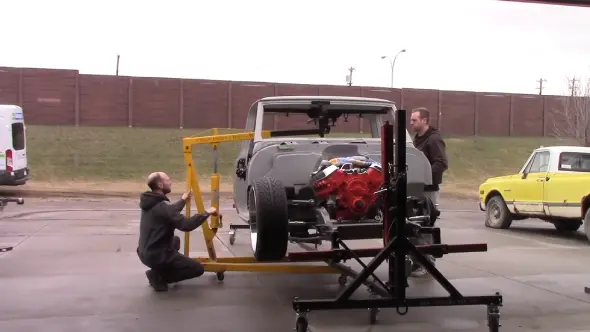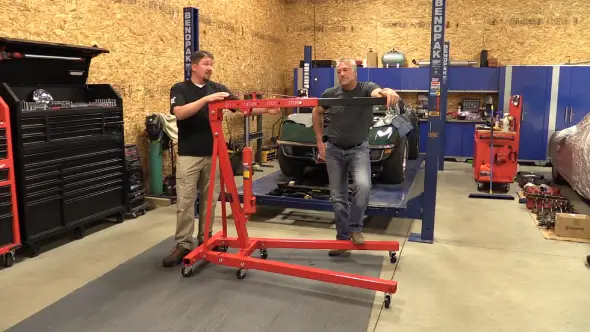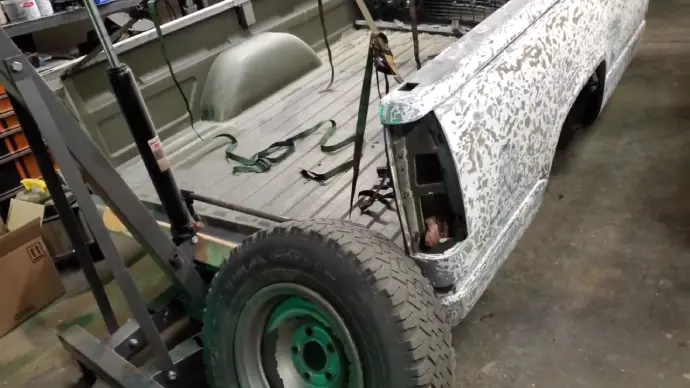Last Updated on April 18, 2023
If you own a truck, chances are good that at some point, you’ll ask yourself: “can an engine hoist lift this vehicle?” If so, you’re not alone. Many drivers have the same question and seek out ways to safely raise their vehicles.
Engine hoists are exactly what they sound like, and they take the strain off your muscles by using hydraulics or manual cranking.
With an engine hoist, you can easily lift the rear of your truck, no matter how heavy. Though bear in mind that most of the weight will be held by the front axle, which can carry 4000 to 5000 pounds depending on the engine model. Therefore, be careful when lifting the front of your heavy-laden truck to be safe.
Buckle up and let’s get lifted off. We’ll explore all of the fascinating details that go into using one, knowledge sure to boost your next project.
How Can An Engine Hoist Lift a Truck: 5 Steps

With the brute strength of an engine hoist, lifting heavy loads of automotive parts and even entire vehicles like trucks is made possible. In order to do this safely, though, certain steps must be respected.
Step 1: Choosing the Right Hoist
When choosing an engine hoist, it is important to consider the size and weight of the vehicle being lifted. Most hoists come with a weight capacity of up to 4 tons, though some may have higher or lower capacities.
It is also essential to make sure that the hoist you choose is compatible with the type of truck you are lifting. For example, if you are lifting a diesel truck, then make sure you choose an engine hoist that can handle heavier loads.
Additionally, ensure the hoist has all necessary safety features, such as slip-resistant chains and non-slip grip handles for secure operation.
Step 2: Choosing a Level, Flat Surface
The next step in using a hoist to lift large freight vehicles is selecting a level surface on which to place the vehicle. An uneven or sloped surface can cause instability when lifting and should be avoided at all costs.
Also, make sure that there are no obstacles nearby that could interfere with the operation of the hoist. If possible, find an open area with plenty of room around it so that you have enough space to move safely as you operate the device.
Step 3: Positioning the Hoist
Once you’ve found a suitable level surface to place your vehicle, position the engine hoist over your desired spot. For example, if you want to raise your truck’s rear, then place the hoist behind the middle of the car’s rear axle.
Ensure it is firmly secured using bolts or other secure fasteners. When positioning your engine hoist, ensure that it is placed at least 2-3 feet away from any obstacles to avoid any potential accidents while operating it later on.
Step 4: Attaching the Chain or Sling
Now comes attaching either a chain or sling onto your vehicle’s frame to secure it while lifting it with the engine hoist. Attach one end of either device to a point near your vehicle’s center of gravity, such as its bumper or axle, for maximum stability during operation.
This will also help prevent any twisting or tipping during lifting operations as well as reduce stress on your vehicle’s bodywork due to uneven weight distribution during lifting operations. Double-check all connections before raising the load to ensure safety during operation later on.
Step 5: Raising the Hoist
Now comes raising your truck with the engine hoist itself. Depending on how powerful and what kind of model you purchased earlier, most models feature two cranks for raising and lowering operations, respectively, and two levers controlling directionality (left/right).
Make sure all controls are properly locked in place before beginning operations. Once everything is set up correctly, start cranking slowly until your desired height has been reached. At this point, stop cranking immediately, but keep your hands on both levers.
Just in case something goes wrong and quickly return down below. If you feel like something isn’t right during operation (this includes any unusual noises coming from either device).
Step 5: Securing the Engine Hoist
Finally comes securing both yourself as well as your load against accidental falls by always keeping them both close together at all times while operating. Double-check each connection between each component, like the chain-fuller link connector or sling-frame connector, before starting anything.
As a final precaution, always wear appropriate safety gear, which includes gloves, steel-toe boots, etc whenever operating an engine hoist.
What Is the Maximum Weight An Engine Hoist Can Lift?

Engine hoists are an incredibly useful tool for lifting and moving heavy objects like trucks or cars, and their capacity can vary greatly depending on the type of hoist used. Generally, hydraulic engine hoists are typically the most powerful option and can lift up to 8 tons (16000 lbs) or even more in some models.
Chain hoists tend to be smaller and lighter but can still lift up to 1 ton (2000 lbs). For heavier lifting needs, some new models offer a capacity of up to 5000 lbs. If you use an engine hoist incorrectly, it can cause serious injury or damage. Keep safety in mind when using one, no matter what type you use.
Is There a Risk Associated With Lifting a Truck With an Engine Hoist?
Lifting a hefty truck with an engine hoist is possible, but unfortunately, the danger involved can too easily be overlooked. Knowing and understanding potential risks is essential before taking on such a task.
The risks of using an engine hoist to lift a truck are as follows:
Structural Failure: The most serious risk of lifting a truck is structural failure. This can occur when too much weight is applied to the frame or suspension, resulting in the engine hoist pushing down on the frame or cab. This results in the bending and cracking of components and the weakening of welds.
Unstable Load: An unbalanced load can cause uneven weight distribution on either side of the hoist apparatus, causing instability and eventually tipping. This can cause severe damage to both the hoist and anyone nearby who could be injured by falling debris or components.
These objects could range from large car parts such as bumpers or hoods down to nuts, bolts, and other small items in the vehicle’s construction.
Insufficient Clearance: In some cases, there may not be enough clearance between the ceiling and floor for safely maneuvering a loaded engine crane. Also, there might be a lack of space for the vehicle being lifted, which can lead to dangerous situations.
Does a hydraulic engine hoist lift a truck higher than a manual one?

Hydraulic engine hoists offer a powerful lifting solution due to their capacity for transmitting greater force than manual models. With the use of pressure created by hydraulic fluid, these machines can effectively raise heavier loads compared to traditional manual ones.
The power and performance of different hoists when lifting a truck are determined by the length of its hydraulic cylinders, the size of its arm assembly, or even its overall capacity.
With this in mind, you can choose the model most suitable for your needs to ensure maximum success from any heavy-duty project.
However, it is crucial to ensure that the hoist is used properly and safely to avoid accidents or damage to the truck being lifted. Understanding your hoist’s weight capacity and maximum lifting height is critical to ensure safe and effective operation.
How big of an engine hoist do I need?
When choosing an engine hoist, it is important to consider the engine’s weight or other heavy loads you will be lifting. The size of the hoist is determined by its maximum weight capacity, which can range from 1 ton to 3 tons or more.
Choosing a hoist with a weight capacity slightly higher than the heaviest load you plan to lift is recommended. Considering the hoist’s size, storage, and maneuverability dimensions would be best.
How much can a 2 ton hoist lift a truck?
This 2 ton hoist can safely lift and transport heavy objects, such as a 4,000-pound truck. It’s important to consider that the weight capacity diminishes when using longer boom arms.
To avoid any potentially hazardous situations or damages caused by incorrect usage of the hoisting device. Always refer back to your manufacturer’s recommended guidelines before operating this equipment.
Why is an engine hoist called a cherry picker?
The term “cherry picker” for an engine hoist is coined from its original use in orchards to harvest cherries. The crane was used to elevate the picker to a certain height so that it could reach the top of the cherry trees.
The device’s design has evolved over time, and it is now commonly utilized for a variety of purposes, including lifting engines.
How high can an engine crane lift a truck?
The height at which an engine crane can lift a truck varies depending on the capacity of the crane. Standard engine cranes may be capable of lifting a truck to a height of around 14 to 24 inches.
However, specialized cranes can lift trucks even higher with up to an 8-ton capacity. Before commencing the lift, the crane’s maximum lifting capacity and height should be taken into account to ensure that it fulfills the requirements of the given operation.
Can a crane lift a 1500-ton truck?
An industrial crane possessing the power to raise an impressive 1500 tons of weight is a must for any job that requires tackling heavy-duty loads. To ensure effective and safe lifting, selecting a crane with a suitable boom length and capacity is essential.
Can a crane lift a 250-ton truck?
Several rail cranes are capable of lifting 250-ton trucks. However, the exact crane model required for the job may vary depending on the vehicle’s weight, size, and shape.
It is vital to correctly assess the object’s weight before attempting to lift it. It ensures that the crane has an adequate capacity, correct rigging and accessories, boom height and positioning, and a precise calculation of the load center.
Therefore, consulting with professional engineers and experienced crane operators is crucial when lifting heavy machinery or vehicles.
Harness the Power of an Engine Hoist: Prepare for Liftoff
Avoid risking a heavy accident and take advantage of the powerful lift capabilities provided by an engine hoist. Don’t forget to double-check that your front and rear axles are securely supported, ensuring that nothing more than 8000 lbs is hanging off your back or front.
However, when it comes to engine hoists, preparation is key. Prior to lifting engines or trucks with the equipment, make sure your vehicle’s suspension and chassis are ready for action. With due diligence, you can safely complete any job at hand using a hydraulic hoist.
